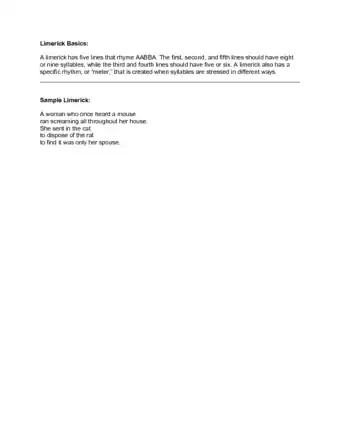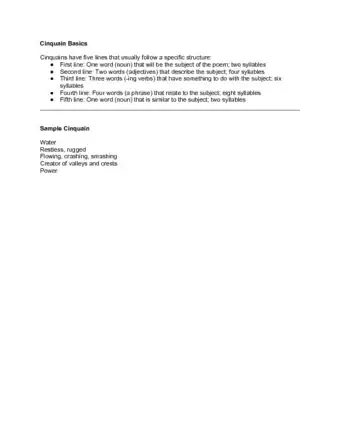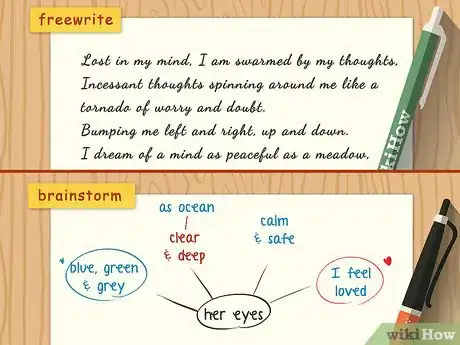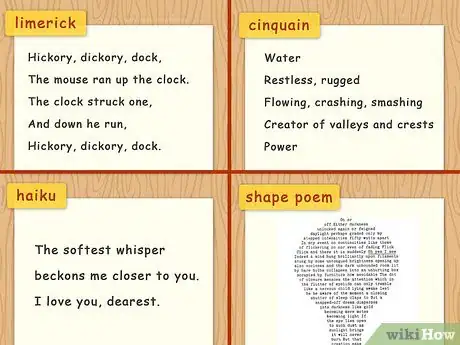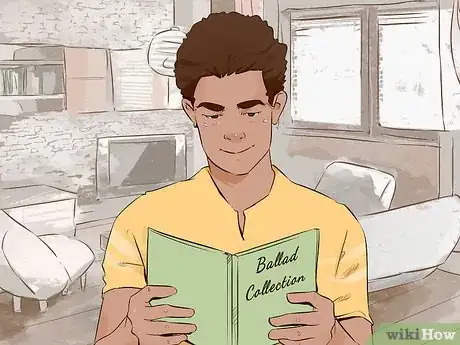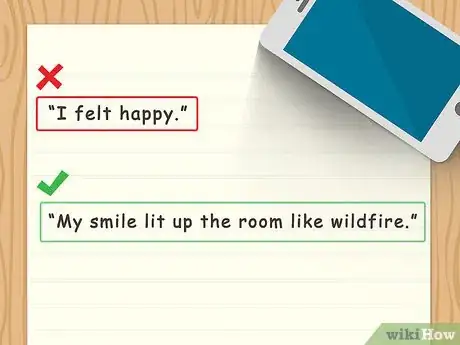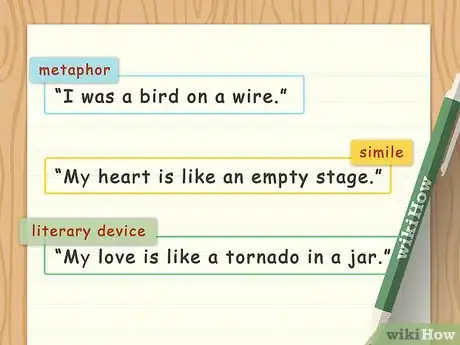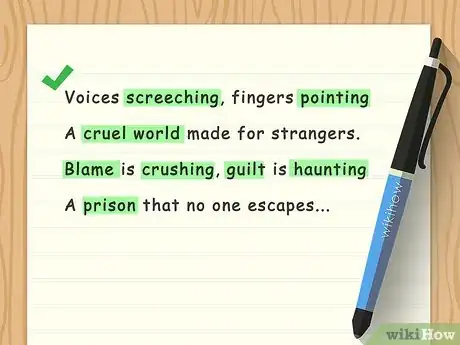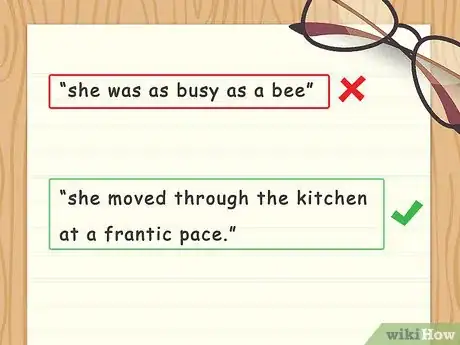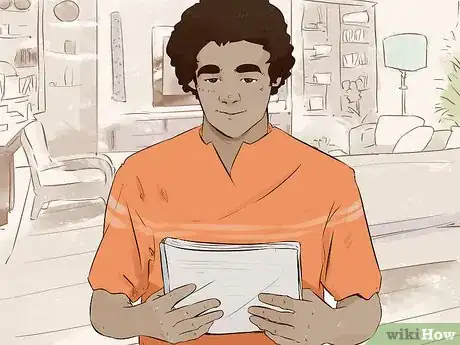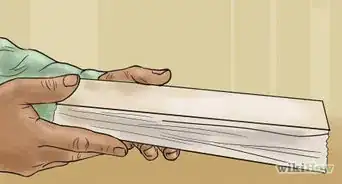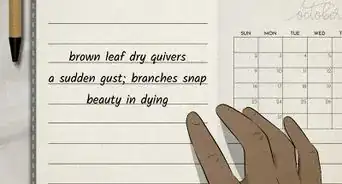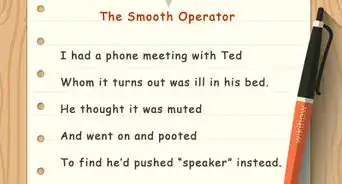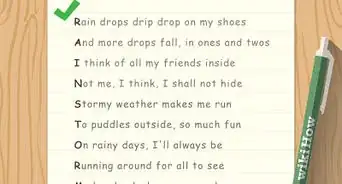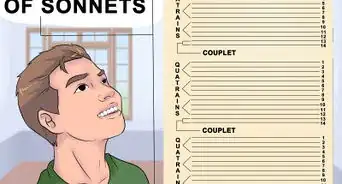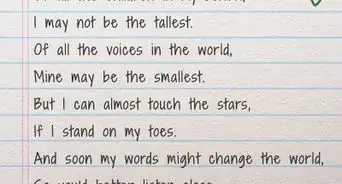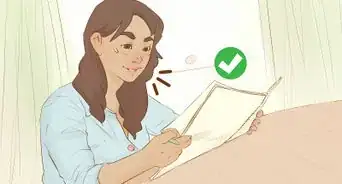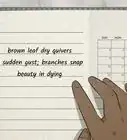This article was co-authored by Alicia Cook. Alicia Cook is a Professional Writer based in Newark, New Jersey. With over 12 years of experience, Alicia specializes in poetry and uses her platform to advocate for families affected by addiction and to fight for breaking the stigma against addiction and mental illness. She holds a BA in English and Journalism from Georgian Court University and an MBA from Saint Peter’s University. Alicia is a bestselling poet with Andrews McMeel Publishing and her work has been featured in numerous media outlets including the NY Post, CNN, USA Today, the HuffPost, the LA Times, American Songwriter Magazine, and Bustle. She was named by Teen Vogue as one of the 10 social media poets to know and her poetry mixtape, “Stuff I’ve Been Feeling Lately” was a finalist in the 2016 Goodreads Choice Awards.
There are 10 references cited in this article, which can be found at the bottom of the page.
wikiHow marks an article as reader-approved once it receives enough positive feedback. This article has 63 testimonials from our readers, earning it our reader-approved status.
This article has been viewed 6,914,140 times.
Writing a poem is about observing the world within or around you. A poem can be about anything, from love to loss to the rusty gate at the old farm. Writing poetry can seem daunting, especially if you do not feel you are naturally or bursting with poetic ideas. With the right inspiration and approach, you can write a poem that you can be proud to share with others in the class or with your friends.
Steps
Sample Poems
Starting the Poem
-
1Do writing exercises. A poem might start as a snippet of a verse, a line or two that seems to come out of nowhere, or an image you cannot get out of your head. You can find inspiration for your poem by doing writing exercises and using the world around you. Once you have inspiration, you can then shape and mould your thoughts into a poem.[1]
Brainstorming for Ideas
Try a free write. Grab a notebook or your computer and just start writing—about your day, your feelings, or how you don’t know what to write about. Let your mind wander for 5-10 minutes and see what you can come up with.
Write to a prompt. Look up poem prompts online or come up with your own, like “what water feels like” or “how it feels to get bad news.” Write down whatever comes to mind and see where it takes you.
Make a list or mind map of images. Think about a situation that’s full of emotion for you and write down a list of images or ideas that you associate with it. You could also write about something you see right in front of you, or take a walk and note down things you see. -
2Get inspired by your environment and those close to you. Inspiration for a great poem is all around you, even if you don’t see it just yet. Think of every memory, situation and moment as a possible topic and you’ll start seeing poetry all around you!
Finding a Topic
Go for a walk. Head to your favorite park or spot in the city, or just take a walk through your neighborhood. Use the people you see and nature and buildings you pass as inspiration for a poem.
Write about someone you care about. Think about someone who’s really important to you, like a parent or your best friend. Recall a special moment you shared with them and use it to form a poem that shows that you care about them.
Pick a memory you have strong feelings about. Close your eyes, clear your head, and see what memories come to the forefront of your mind. Pay attention to what emotions they bring up for you—positive or negative—and probe into those. Strong emotional moments make for beautiful, interesting poems.Advertisement -
3Pick a specific theme or idea. You can start your poem by focusing on a specific theme or idea that you find fascinating. Picking a specific theme or idea to focus on in the poem can give your poem a clear goal or objective.This can make it easier for you to narrow down what images and descriptions you are going to use in your poem.[2]
- For example, you may decide to write a poem around the theme of “love and friendship.” You may then think about specific moments in your life where you experienced love and friendship as well as how you would characterize love and friendship based on your relationships with others.
- Try to be specific when you choose a theme or idea, as this can help your poem feel less vague or unclear. For example, rather than choosing the general theme of “loss,” you may choose the more specific theme, such as “loss of a child” or “loss of a best friend.”
-
4Choose a poetic form. Get your creative juices flowing by picking a form for your poem.There are many different poetic forms that you can use, from free verse to sonnet to rhyming couplet.You may go for a poetic form that you find easy to use, such as free verse, or a form that you find more challenging, such as a sonnet. Choose one poetic form and stick to that structure so your poem feels cohesive to your reader.[3]
- You may decide to try a poetic form that is short, such as the haiku, the cinquain, or the shape poem. You could then play around with the poetic form and have fun with the challenges of a particular form. Try rearranging words to make your poem sound interesting.
- You may opt for a form that is more funny and playful, such as the limerick form, if you are trying to write a funny poem. Or you may go for a more lyrical form like the sonnet, the ballad, or the rhyming couplet for a poem that is more dramatic and romantic.
-
5Read examples of poetry. To get a better sense of what other poets are writing, you may look through examples of poetry. You may read poems written in the same poetic form you are interested in or poems about themes or ideas that you find inspiring. You may also choose poems that are well known and considered “classics” to get a better sense of the genre. For example, you may read:
- “Kubla Khan” by Samuel Taylor Coleridge[4]
- “Song of Myself” by Walt Whitman[5]
- “I measure every Grief I meet” by Emily Dickinson[6]
- “Sonnet 18” by William Shakespeare[7]
- “One Art” by Elizabeth Bishop[8]
- “Night Funeral in Harlem” by Langston Hughes[9]
- “The Red Wheelbarrow” by William Carlos Williams [10]
Writing the Poem
-
1Use concrete imagery. Avoid abstract imagery and go for concrete descriptions of people, places, and things in your poem. You should always try to describe somethingusing the five senses: smell, taste, touch, sight, and sound.Using concrete imagery will immerse your reader in the world of your poem andmake images come alivefor them.[11]
- For example, rather than try to describe a feeling or image with abstract words, use concrete words instead. Rather than write, “I felt happy,” you may use concrete words to create a concrete image, such as, “My smile lit up the room like wildfire.”
-
2Include literary devices. Literary devices like metaphor and simile add variety and depth to your poetry. Using these devices can make your poem stand out to your reader and allow you to paint a detailed picture for your reader. Try to use literary devices throughout your poem, varying them so you do not use only metaphors or only similes in your writing.[12]
Try a New Literary Device
Metaphor: This device compares one thing to another in a surprising way. A metaphor is a great way to add unique imagery and create an interesting tone. Example: “I was a bird on a wire, trying not to look down.”
Simile: Similes compare two things using “like” or “as.” They might seem interchangeable with metaphors, but both create a different flow and rhythm you can play with. Example: “She was as alone as a crow in a field,” or “My heart is like an empty stage.”
Personification: If you personify an object or idea, you’re describing it by using human qualities or attributes. This can clear up abstract ideas or images that are hard to visualize. Example: “The wind breathed in the night.”
Alliteration: Alliteration occurs when you use words in quick succession that begin with the same letter. This is a great tool if you want to play with the way your poem sounds. Example: “Lucy let her luck linger.” -
3Write for the ear. Poetry is made to be read out loud and you should write your poem with a focus on how it sounds on the page. Writing for the ear will allow you to play with the structure of your poem and your word choice.Notice how each line of your poem flows into one another and how placing one word next to another creates a certain sound[13]
- For example, you may notice how the word “glow” sounds compared to the word “glitter.” “Glow” has an “ow” sound, which conjures an image of warmth and softness to the listener. The word “glitter” is two syllables and has a more pronounced “tt” sound. This word creates a sharper, more rhythmic sound for the listener.
-
4Avoid cliche. Your poetry will be much stronger if you avoid cliches, which are phrases that have become so familiar they have lost their meaning. Go for creative descriptions and images in your poem so your reader is surprised and intrigued by your writing. If you feel a certain phrase or image will be too familiar to your reader, replace it with a more unique phrase.[14]
- For example, you may notice you have used the cliche, “she was as busy as a bee” to describe a person in your poem. You may replace this cliche with a more unique phrase, such as “her hands were always occupied” or “she moved through the kitchen at a frantic pace.”
Polishing the Poem
-
1Read the poem out loud. Once you have completed a draft of the poem, you should read it aloud to yourself. Notice how the words sound on the page. Pay attention to how each line of your poem flows into the next.Keep a pen close by so you can mark any lines or words that sound awkward or jumbled.[15]
- You may also read the poem out loud to others, such as friends, family, or a partner. Have them respond to the poem on the initial listen and notice if they seem confused or unclear about certain phrases or lines.
-
2Get feedback from others. You can also share your poem with other poets to get feedback from them and improve your poem. You may join a poetry writing group, where you workshop your poems with other poets and work on your poetry together. Or you may take a poetry writing class where you work with an instructor and other aspiring poets to improve your writing. You can then take the feedback you receive from your peers and use it in your revision of the poem.[16]
-
3Revise your poem. Once you have received feedback on your poem, you should revise it until it is at its best. Use feedback from others to cut out any lines to feel confusing or unclear. Be willing to “kill your darlings” and not hold onto pretty lines just for the sake of including them in the poem.Make sure every line of the poem contributes to the overall goal, theme, or idea of the poem.[17]
- You may go over the poem with a fine-tooth comb and remove any cliches or familiar phrases. You should also make sure spelling and grammar in the poem are correct.
Community Q&A
-
QuestionWhat is the best way to end a poem?
 Community AnswerEnd it with the most emotional word (the darkest, happiest or even saddest word you can think of).
Community AnswerEnd it with the most emotional word (the darkest, happiest or even saddest word you can think of). -
QuestionHow do I use good words in the poem?
 Community AnswerRead plenty of poetry. Study them. Think about the ones that touch you deeply. What did you like about them? And then sit down and listen to your heart. The right words will come.
Community AnswerRead plenty of poetry. Study them. Think about the ones that touch you deeply. What did you like about them? And then sit down and listen to your heart. The right words will come. -
QuestionHow do I write a poem about nature?
 Community AnswerSpend time in nature, looking around and seeing what inspires you. If you can't get outside, look at online images of nature, or your own photos from a visit to a park or the countryside. Write down a list or mind map of words that are inspired by thinking about nature. Include your emotions. Then use this brainstorming preparation to write your poem, basing it on how nature makes you feel, what you like about nature and what sorts of things other people can get from understanding their relationship to the natural world.
Community AnswerSpend time in nature, looking around and seeing what inspires you. If you can't get outside, look at online images of nature, or your own photos from a visit to a park or the countryside. Write down a list or mind map of words that are inspired by thinking about nature. Include your emotions. Then use this brainstorming preparation to write your poem, basing it on how nature makes you feel, what you like about nature and what sorts of things other people can get from understanding their relationship to the natural world.
References
- ↑ http://www.creative-writing-now.com/how-to-write-a-poem.html
- ↑ http://jerz.setonhill.edu/writing/creative1/poetry-writing-tips-how-to-write-a-poem/
- ↑ http://grammar.yourdictionary.com/grammar-rules-and-tips/tips-on-writing-poems.html
- ↑ http://www.thetimes.co.uk/tto/public/poetrycompetition/article3229003.ece
- ↑ https://www.poetryfoundation.org/poems/45477/song-of-myself-1892-version
- ↑ https://www.poets.org/poetsorg/poem/i-measure-every-grief-i-meet-561
- ↑ http://www.thetimes.co.uk/tto/public/poetrycompetition/article3228813.ece
- ↑ https://www.poetryfoundation.org/poems/47536/one-art
- ↑ https://www.poets.org/poetsorg/poem/night-funeral-harlem
- ↑ https://www.poetryfoundation.org/poems/45502/the-red-wheelbarrow
- ↑ http://jerz.setonhill.edu/writing/creative1/poetry-writing-tips-how-to-write-a-poem/
- ↑ http://jerz.setonhill.edu/writing/creative1/poetry-writing-tips-how-to-write-a-poem/
- ↑ http://www.creative-writing-now.com/how-to-write-a-poem.html
- ↑ http://www.creative-writing-now.com/how-to-write-a-poem.html
- ↑ http://jerz.setonhill.edu/writing/creative1/poetry-writing-tips-how-to-write-a-poem/
- ↑ http://jerz.setonhill.edu/writing/creative1/poetry-writing-tips-how-to-write-a-poem/
- ↑ http://jerz.setonhill.edu/writing/creative1/poetry-writing-tips-how-to-write-a-poem/
About This Article
Writing a poem can seem intimidating at first, but with a little patience and inspiration, you can produce a beautiful work of written art. If you’re not sure what to write about, spend a few minutes jotting down whatever thoughts come into your head. Think about your feelings, your experiences and memories, people in your life, or things that you sense in your environment and see if any of those things inspire you. You can also try working from writing prompts. Once you’ve done some free writing, look for themes and ideas in what you’ve written, and choose one that feels inspiring to you. Common themes include things like love, loss, family, or nature. After you choose a theme, think about how you’d like to structure the poem. For example, you might stick to a traditional format, such as a limerick, haiku, or quatrain. If you’d rather not feel constrained by rhymes or meter, consider writing a free verse poem and simply let the words flow in whatever way feels right. You can also read poems by other authors to get ideas and inspiration. When you’re writing the poem, look for ways to express your thoughts using powerful, sensory language. For example, instead of saying something like “I felt happy,” try using a colorful simile, like “My heart soared like a bird set free.” As you’re writing, also think about how the poem will sound when read out loud. Try reading it to yourself or a friend to see if it’s pleasing to the ear. If a word or phrase doesn’t flow the way you like, replace it with something else that has a similar meaning. You might not be satisfied with the first draft of your poem, and that’s totally okay. Read it to yourself, get feedback from friends, teachers, or other people you trust, and keep revising until you feel like you’ve created a poem that really captures the feelings you’re trying to convey. For help choosing a structure for your poem, like a haiku, limerick, or sonnet, read the article!
